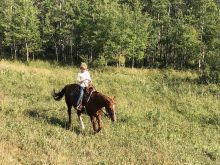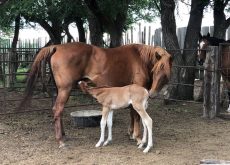Steve, 62, and Sarah, 60, have run a successful farming operation in western Manitoba for the last 35 years. The farm consists of personally held farm assets and seven quarter sections of cropland.
Steve and Sarah have two sons. Jared is 32 and Jack is 30 years old. Jared has been working on the farm full time for the last 10 years, since returning to the farm after university. Jack lives with a disability and has been a full-time resident in an assisted living facility since he was 18 years old.
Jared has proved over the last decade that he is more than capable of taking over the farm operation. Steve and Sarah believe now is a good time to start the succession planning process and transferring ownership of the farm over to Jared.
Read Also

Gentle treatments for pain in the neck
Heading toward year-end, people unknowingly tense up against the cold and busyness, causing neck pain that can often be treated with appropriate support and gentle mobility, athletic therapist Kathlyn Hossack says.
Steve and Sarah have accumulated a significant amount of off-farm wealth: $200,000 in their tax-free savings accounts, $300,000 in registered retirement savings plans and $750,000 in non-registered investments. They also know if Jared is taking over the farm completely, it makes sense for him to move into the farmhouse. Thus, they will likely have to find a new place to live.
Because the couple’s issues are complex, Steve and Sarah approached Forbes Wealth Management’s Nathan Heppner, a certified financial planner, and Erik Forbes, a registered financial planner, in Carberry, Man., for solutions.
Further planning for Jack is required. Individuals living with a disability are usually eligible for the Disability Tax Credit and, with it, provincial social programs. However, these programs are generally asset and income tested. This means if Jack were to inherit assets directly, he may lose his access to these social benefits, notes Erik Forbes.
Many factors to consider
Steve and Sarah need a plan to maintain their lifestyle through retirement, preserve the sustainability of the farm, pass the farmhouse to Jared, move to town and provide fairly for Jack.
Based on their current assets and an analysis performed, assuming a modest 6.5 per cent rate or return, 2.1 per cent inflation and full Canada Pension Plan and Old Age Security benefits, Steve and Sarah’s assets should provide an income of roughly $7,650 per month until his age of 100. They live a modest lifestyle, so this will likely be enough to sustain them.
For Jared, the transaction is straightforward. Steve and Sarah could sell the farmhouse to Jared for any value in theory, however, they would likely sell it to him either at a value equal to the new house they move into or market value. Regardless of what price it is sold at, there will be no capital gains tax due to the principal residence exemption.

Passing on the farmland
Passing on the farmland is a more complex issue. With farmland, parents can pass it down to the next generation at any value between book value and market value. The book value of their seven quarters is $280,000 ($500 per acre), and the current market value is $3,080,000 ($5,500 per acre).
Another thing to keep in mind is Steve and Sarah’s ability to utilize the Lifetime Capital Gains Tax Exemption. This tax exemption allows for the gain of $1,000,000 in the farmland to be exempt from capital gains tax. Both Steve and Sarah should be eligible, in essence bumping up the book value of the land by $2,000,000 for the next generation, says Heppner. Table 1 explains the solution.
If the couple transferred ownership of the land outright to Jared at market value, they would have $400,000 of taxable capital gain plus some AMT (Alternative Minimum Tax) tax payable.
If they wanted to transfer ownership outright to Jared while minimizing taxes, they could transfer it at a value of $2,280,000. Doing this would result in no taxable capital gain; however, there would still be AMT tax payable.
Caution advised
Steve and Sarah should be cautious about transferring ownership of the farmland outright to Jared for several reasons, such as there may come a time when they need a bit of income from the land. Also, if they transfer ownership to Jared outright, the land may be accessible to Jared’s creditors or an estranged spouse if he gets into financial or marital issues.
Rather than transferring ownership of the land outright to Jared, it would be prudent for them to use a promissory note, where interest payments would be equal to cash rent values. Steve and Sarah could then use that income to sustain their lifestyle or set it aside as part of Jack’s inheritance.
Alternatively, and potentially the best option, the proceeds that Steve and Sarah receive could be used to pay the premiums on a joint last-to-die, whole life, insurance policy on their own lives.
If they know how much they want Jack to inherit, they could apply for the joint policy and have the payments Jared is making for the land equal to the premium amounts. Or, if the couple is apprehensive about insurance or limited by health complications, they could invest the money in a non-registered investment account, Erik Forbes explains.
Jack’s inheritance
When it comes to Jack’s inheritance, whether it is real assets, investments or life insurance proceeds, it is very important that he is not listed as a direct beneficiary of any assets (i.e., investments, life insurance, etc.). If Jack inherits anything directly, he could lose access to disability benefits.
Rather, everything Jack inherits should flow through Steve and Sarah’s estate. In each of their wills, it should be stipulated that everything destined for Jack should be put into a Henson Trust, which is a discretionary trust for persons living with a disability. Having his inheritance distributed this way will ensure Jack won’t lose access to his social benefits.
Some thought should be given to who Steve and Sarah would like to designate as the trustee. The most logical choice would likely be Jared, Nathan Heppner concludes.















